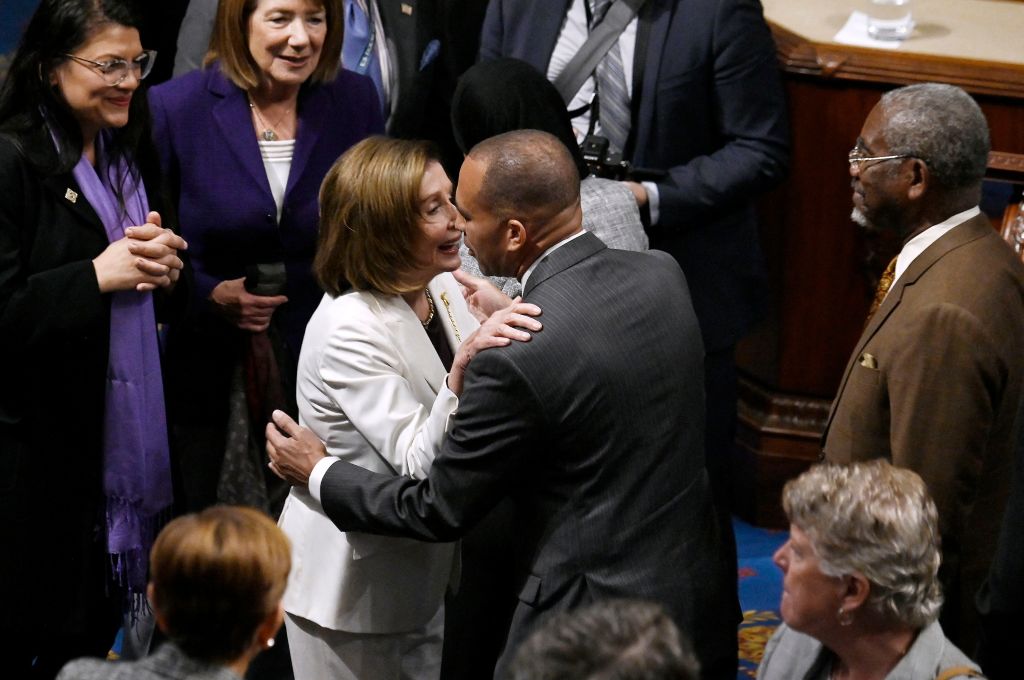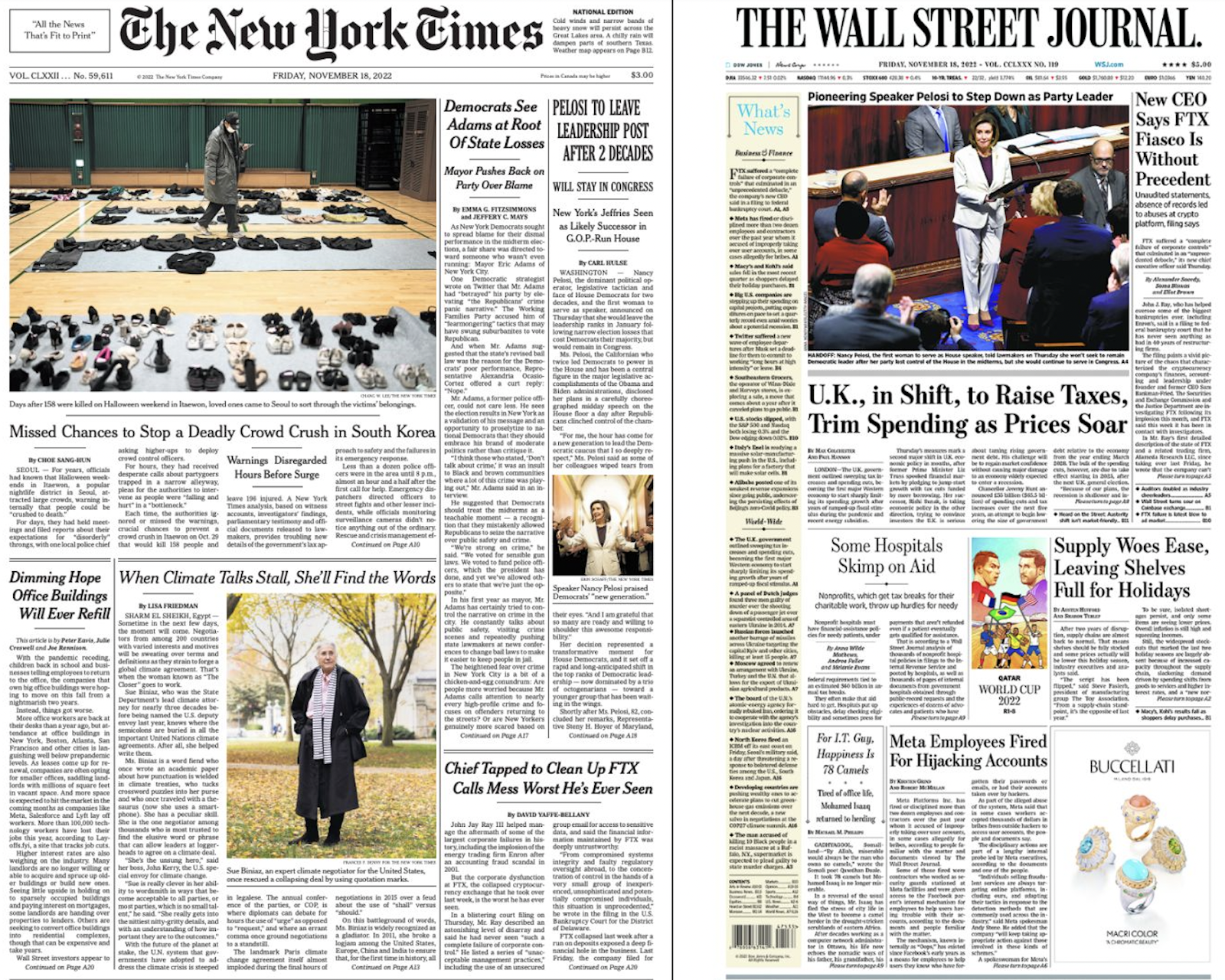PRESENTED BY

THE TOP

Happy Friday morning.
Thursday’s historic announcements by Speaker Nancy Pelosi and House Majority Leader Steny Hoyer were a watershed moment for House Democrats.
Along with signals that House Majority Whip Jim Clyburn will remain at the leadership table but in a lower-profile role, Democrats avoided a messy public fight over who runs the caucus heading into the 118th Congress. Pelosi, Hoyer and Clyburn will step aside – although they’re not gone – to be succeeded by Reps. Hakeem Jeffries (D-N.Y.), Katherine Clark (D-Mass.) and Pete Aguilar (D-Calif.).
The Big Three are to be replaced by the New Three — seamlessly, gracefully and, above all, respectfully.
Yet behind the scenes, it didn’t go down quite like that. Up until very shortly before Pelosi declared she was stepping down from the leadership, several of the key players weren’t quite sure how the transition would unfold.
Clark was concerned about a potential challenge from Hoyer, one the Maryland Democrat is convinced he would’ve won. Clyburn and Aguilar had a private conversation about making sure that the 43-year-old California Democrat is No. 3 in the leadership hierarchy, not his more senior colleague. Clyburn still hasn’t officially announced his role yet, a topic that has been under discussion for months.
Yes, this was a transition in leadership, but it’s also a transition in generations. Once rivals, Pelosi and Hoyer took over as the top two House Democrats in 2002. Clyburn joined them in 2006. Jeffries and Clark only started in the House in 2013, while Aguilar entered office in 2015. The experience gap between the two factions is enormous; any one of the three senior Democrats has been in the House for longer than the younger trio combined. Hoyer came to Capitol Hill when Ronald Reagan was a new president, and he first became part of the Democratic leadership in 1987.
The Pelosi-Hoyer-Clyburn trio has won and lost majorities together, and their relationships endured enormous stresses. Pelosi and Hoyer’s leadership battle during 2001 is well known, but people forget that Hoyer and Clyburn briefly ran against each other in 2010 after Democrats lost the House. That dispute was resolved and both remained in place. The triumvirate eventually settled into a pattern that worked for them and the broader caucus.
While Pelosi’s plans in the event of a Democratic defeat this fall were the big headline nationally – and rightly so considering her place in history – the sensitivities surrounding Hoyer and Clyburn were in many ways more intense, especially since it was clear that both were staying in Congress no matter what happened in the midterms. The two are enormously respected by their colleagues, and no one wanted to be seen as trying to force them out of leadership. Attempting to do so may not have been successful anyway.
The 83-year-old Hoyer was quiet about his plans throughout the fall, insisting that the only post he was interested in was House majority leader. Like Pelosi, Hoyer spent a lot of time on the road during the final months of the cycle. Thanks to his moderate image, Hoyer could go to some districts that Pelosi couldn’t, and he helped raise millions of dollars for candidates and incumbents.
Even after Election Day, Hoyer declined to discuss his intentions, hoping for a Democratic comeback. When it was clear that Republicans were going to take the majority, Hoyer still held back his announcement until Pelosi went first.
Earlier this week, Hoyer met with Jeffries and told the New York Democrat that he’d back him for Democratic leader. Here’s Hoyer in a letter to colleagues on Thursday:
“Now is the time for a new generation of leaders, and I am proud to offer my strong endorsement to Hakeem Jeffries for Democratic Leader, a role in which he will make history for the institution of the House and for our country.”
Yet some Democrats privately urged Hoyer to stay in leadership, and tension grew between Hoyer and Clark over whether Hoyer would run for minority whip. Because Hoyer wasn’t disclosing his plans, it wasn’t clear to the Clark camp what he’d do until Thursday afternoon when Pelosi went to the floor. After Pelosi’s speech, we scooped that Hoyer wouldn’t run for leadership in the next Congress.
We asked Hoyer about his colleagues asking him to run for leadership. We never mentioned Clark or the minority whip post, but Hoyer’s response is interesting:
Q. “There were some members who wanted you to stay.”
Hoyer: “I would’ve won.”
Q. “Oh, you would’ve?”
Hoyer: “No doubt about it. But that was not the issue. I was minority whip for 12 years.”
Clark praised Hoyer in a statement on Thursday: “There are no better words to describe Leader Hoyer than a true public servant. He has been instrumental to the success of the House Democratic Caucus as a leader, mentor, and master legislator.”
The 82-year-old Clyburn was also active on the campaign trail, with endangered Democrats happy to see him come to their districts. Clyburn’s endorsement is a valuable thing in the right place and at the right time, as President Joe Biden can attest.
Clyburn and Jeffries first discussed a potential “emeritus” position for the South Carolina Democrat earlier in the fall. If Clyburn stepped aside, the Congressional Black Caucus — a roughly 50-member voting bloc — would line up behind Jeffries for whatever leadership position he pursued.
But just what position Clyburn would hold, and more importantly where it would rank within the Democratic leadership structure, was still to be sorted out.
Hoyer and Clyburn meet privately this week as well. The two had talked about their futures during the last several months, and then explored it in more depth during this session. We reported earlier this week about rumblings inside Democratic leadership circles that Clyburn would throw his support to Jeffries if Hoyer ran against the New Yorker for minority leader. Yet Hoyer never had any intentions of doing that, as we noted above.
Clyburn and Aguilar talked about Clyburn’s plans during a huddle on Thursday morning. Clyburn would stay on as assistant Democratic leader but that position would essentially be removed from the top leadership hierarchy, allowing Aguilar — as caucus chair — to serve as the No. 3 Democrat.
Aguilar didn’t want to be seen as trying to step over Clyburn, currently the highest ranking Black lawmaker ever. Like the rest of the caucus, Aguilar is deferential to Clyburn. But it’s also deeper than that. The two have developed a close personal bond, with Aguilar serving as a chief deputy whip, a position that afforded him weekly facetime with Clyburn. Aguilar has been to Charleston to see Clyburn.
On Thursday, Jeffries walked off the House floor a few hours after Pelosi announced her intention to step down from leadership. He wouldn’t say much, instead allowing Pelosi to have her day. But as Jeffries crossed through Statuary Hall with a large group of reporters in tow, he ran into Clyburn.
“It’s on,” Clyburn said.
– John Bresnahan, Heather Caygle and Jake Sherman
NEXT WEEK: Don’t forget to RSVP for our virtual one-on-one conversation with Rep. Suzan DelBene (D-Wash.) on Monday, Nov. 21 at 12 p.m. ET. It’s the second event in our three-part series, “Building Trust in Technology.” We’ll be talking to DelBene about the importance of privacy and security in new and existing technologies.
PRESENTED BY CHEVRON
As the world grows, the energy demands grow with it. At Chevron, we’re working to help lower the carbon intensity of the fuels that support the heavy-duty transport sector. And, we’re expanding our portfolio of innovative, renewable fuels, like our renewable diesel made from bio feedstocks like plants, animal fats, and used cooking fats. Find out more about our renewable fuels.
HISTORY IN THE MAKING
The Senate marches toward approving same-sex marriage
The Senate took yet another step forward on Thursday night to making the right to same-sex marriage the law of the land.
Just after 10 p.m., the chamber voted 53-23 to advance the legislation repealing the Defense of Marriage Act and codifying into federal law the right to same-sex marriage.
Twenty-four senators – 20 Republicans and three Democrats – skipped the vote, the chamber’s last before the Thanksgiving recess kicked off.
Senate Majority Leader Chuck Schumer announced that the Senate would continue work on the legislation when it returned to town on Monday, Nov. 28. Schumer filed cloture on both a bipartisan substitute amendment and the underlying bill on Thursday night.
“We will hold a cloture vote on the substitute amendment when the Senate comes back into session the Monday after Thanksgiving,” Schumer said on the floor shortly before the vote. “Let me be clear: passing the Respect for Marriage Act is not a matter of ‘if’ but only of ‘when.’”
Schumer added: “I thank my colleagues from both sides of the aisle who’ve led this bill and I have zero doubt that Respect for Marriage will soon be the law of the land.”
Schumer’s patience has been rewarded on this issue. He delayed consideration of the legislation until after the election at the behest of senators who said it would garner more support that way. This has turned out to be the case, and the Senate is on its way to passing the measure in early December. The bill will have to go back to the House after that, but there’s significant bipartisan support in that chamber. Then it will head to President Joe Biden for his signature.
– Jake Sherman and John Bresnahan
ATTENTION SOUTH CAPITOL STREET
What’s next in the fight to change the DCCC rules
The effort to return the DCCC chair to position selected by the Democratic leader is entering a crucial stage. We reported last week that Reps. Suzan DelBene (D-Wash.), Mark Pocan (D-Wis.) and Brad Schneider (D-Ill.) were proposing a rules change that would stop the practice of the Democratic Caucus electing the head of the House campaign arm and allowing the Democratic leader to appoint that person instead.
Here’s the text of the amendment:
“No later than February 15 of the first session of a new Congress the Speaker or Democratic Leader shall nominate a chair of the DCCC. Such nomination shall be submitted to the Caucus. No later than March 1 of the first session of a new Congress, the Caucus shall vote on that nomination, and other nominations which may be made from the floor on the petition of five Members of the Caucus.”
In other words, the Democratic leader taps a chair and the caucus has to ratify that selection.
What’s next? The three Democrats — who span the ideological spectrum inside the caucus — have already submitted the proposed amendment to the Committee on Caucus Procedures.
On Nov. 28, members of the Caucus Procedures committee will meet virtually and consider proposed rule changes, including the DCCC amendment. The members will vote whether to recommend the amendment to the caucus favorably or unfavorably.
Later that week, the full caucus will vote on whether to approve the proposal.
Here’s more from Pocan, Schneider and DelBene:
First, this proposal will allow the Chair to focus on results. The Chair must be responsive to the Caucus and to our Members; after all, our Members know best how to win tough races in our respective regions. This change will help the Chair to take all of that into consideration while making the tough calls necessary to win the majority.
Second, the proposal will create accountability for winning the majority. … Our leaders should be held accountable for whether or not we win races and ultimately the majority. Allowing the Democratic Leader to select the DCCC Chair will make it clear the buck stops with our leadership.
Third, we believe this rules change will empower the DCCC Chair. If the Democratic Leader appoints the DCCC Chair, that person will necessarily have the confidence of the Leader. The chief concern of the DCCC Chair will be winning the majority rather than winning an intra-Caucus election.
Rank-and-file House Democrats successfully pushed for the DCCC chair position to be elected by members in November 2016. Democrats wanted more input into the direction of the DCCC and wanted to take some power away from Speaker Nancy Pelosi.
But following DCCC Chair Sean Patrick Maloney’s high-profile defeat on Election Day, some members believe the chair should be a member in a safe seat.
— Max Cohen
PRESENTED BY CHEVRON

At Chevron, we’re developing and expanding renewable fuels that can help reduce the lifecycle carbon emissions of transportation fuels.
THE CAMPAIGN
| → | Chicago Mayor Lori Lightfoot is already running ads for her 2023 primary, which will take place in February. Rep. Chuy Garcia (D-Ill.) has announced he’s running against Lightfoot. The Lightfoot spot has two men playing video games and talking about public safety. |
– Jake Sherman

Earlier this week, we were joined by Locust Street Group’s Phillip Morris, for a conversation about The Canvass. Morris gave insight into the accuracy of our respondents who took part in The Canvass Capitol Hill and K Street.
| → | The Canvass correctly predicted that Republicans would win the House and Democrats would hold the Senate. |
| → | The Canvass Capitol Hill correctly predicted the winner in key Senate races in Arizona, Colorado, Florida, North Carolina, Nevada, Ohio, Pennsylvania and Wisconsin. |
| → | The Canvass K Street correctly predicted the winner in all but one of the top Senate races. K Street only got Nevada wrong. |
| → | The Canvass Capitol Hill and K Street also correctly identified the most important issues that would define the midterms. This was confirmed afterward by exit polls: Inflation, the economy, abortion, and crime and public safety. |
Thank you to Natalie Jones, Puru Trivedi, Katherine Boyce of Meridian International Center for hosting this conversation.
And thank you to our Canvass participants for sharing your thoughts with us every month. Want to get into the mix? Join The Canvass Capitol Hill. Qualify to take the K Street survey? Sign up now!
MOMENTS
10:15 a.m.: President Joe Biden will get his daily intelligence briefing.
1:30 p.m.: Biden will meet with business and labor leaders. Treasury Secretary Janet Yellen will also attend.
2:45 p.m.: Karine Jean-Pierre will brief.
CLIP FILE
NYT
| → | “Will Taxing the Windfall Profits of Oil Giants Fix Countries’ Economies?” by Patricia Cohen in London |
| → | “Meet the ‘Closer’ Who Finds the Right Words When Climate Talks Hit a Wall,” by Lisa Friedman in Sharm El Sheikh, Egypt |
WaPo
| → | Analysis: “‘I feel balanced about it all’: Nancy Pelosi reflects on two decades at the top,” by Paul Kane |
| → | “North Korea fires suspected intercontinental ballistic missile,” by Michelle Ye Hee Lee in Seoul |
AP
| → | “US moves to shield Saudi crown prince in journalist killing,” by Ellen Knickmeyer and Matthew Lee |
Bloomberg
| → | “Musk’s ‘Hardcore’ Ultimatum Sparks Exodus, Leaving Twitter at Risk,” by Kurt Wagner and Davey Alba |
PRESENTED BY CHEVRON
At Chevron, we’re working to help fuel a lower carbon future. We’re turning to innovative fuel sources, like renewable natural gas sourced from cow waste and renewable diesel sourced from bio feedstocks, to help lower the lifecycle carbon emissions of the heavy-duty transport fuels. While we work to expand our renewable fuel production to 100,000 barrels per day by 2030, our renewable fuels are ready to be put to use in the tanks of trucks, trains, and heavy-duty equipment today. Find out more about our initiatives.
Editorial photos provided by Getty Images. Political ads courtesy of AdImpact.

Crucial Capitol Hill news AM, Midday, and PM—5 times a week
Join a community of some of the most powerful people in Washington and beyond. Exclusive newsmaker events, parties, in-person and virtual briefings and more.
Subscribe to Premium
The Canvass Year-End Report
And what senior aides and downtown figures believe will happen in 2023.
Check it out










